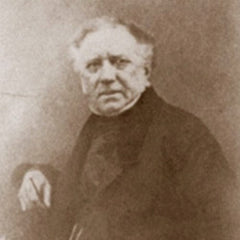William Shayer was an accomplished British painter of figures and rural scenes.
Early Years
Born the son of a publican, Shayer was raised in the ‘Horse and Jockey’ pub in Southampton, Hampshire. His father passed away early in life, leaving his widowed mother to take care of the family single handed while also serving customers. As such, to generate some much needed income, he was sent to work as a young lad, decorating rush-bottom chairs. Subsequently undertaking an apprenticeship as a carriage painter.
Several artists from this period began their careers as carriage painters and it was far from an easy endeavour. Aside from the skills required for paint preparation, apprentices were expected to learn how to apply designs accurately and with care. Shayer excelled and was soon employed as a heraldic painter for George Parsons of Chichester, a coachbuilder. It’s said that he possessed a keen eye for detail and developed a solid reputation for the quality of his craft.
In his spare time, he produced copies of engravings and etchings to supplement his income. All the while honing his draughtsmanship and gaining experience of old master prints.
A Generous Patron
In 1819, with the encouragement of a generous local patron, Michael Hoy, he began to establish himself as a painter in oils. The following year debuting at London’s Royal Academy. His subjects were the ‘rural poor’, for want of a better expression. The local working communities of Hampshire, particularly the New Forest. He painted the everyday scenes he witnessed and the people he interacted with. His scenes are comparable with those of George Morland (1763-1804) and Edmund Bristow (1787-1876).
Painting The Community
Painting the ‘poor’ was a Victorian endeavour fraught with complexity as critics often scorned those who reminded viewers of the symptoms of their abject poverty. Peasants, as they were usually referred to, needed to be seen as hard-working, in relatively good health, and morally upstanding. In recent years, historians have suggested that Shayer was influenced by these demands and overly romanticised his portrayals. However, it’s more likely that he simply focused on the positive aspects of close-knit brethren, community togetherness, and good honest labour. After all, he too faced the day-to-day struggles of providing for an extensive family.
In terms of his technique, he blended an advanced understanding of composition with a sympathetic eye and a keen wit. He’d also gained experience in using glazes via his work as a heraldic painter and adapted this with great success. When painting faces, for example, he often applied a thin transparent layer atop dry opaque oil paint to create a glowing effect.
With his stock rising, several of his peers urged him to move to London to further his opportunities. These included the animal painter, Thomas Sidney Cooper (1803-1902), who was an admirer. He declined, however, resolute to remain in Southampton where he spent his entire life. He often reminded them that he was selling works as quickly as he could paint them - straight from the easel.
Alongside his fruitful career as a painter, he worked as a drawing master, also producing designs for the local theatre. Finally retiring in 1870 due to failing eyesight.
William Shayer exhibited at the Royal Academy, British Institution, and the Society of British Artists. He’s represented in numerous public collections including the V&A Museum, Tate Gallery, and New York’s Met Museum. Four of his sons, including William Joseph Shayer Jnr (1811-1892), also became painters.
Exhibited
Royal Academy, British Institution, Society of British Artists.
Public Collections
Tate Gallery, Glasgow Art Gallery, the Met in New York,.British Embassy at The Hague, Government Art Collection, Bristol Museum & Art Gallery, Burton Art Gallery and Museum, Cliffe Castle Museum, Cyfarthfa Castle Museum & Art Gallery, Danum Gallery Library and Museum, Defence Academy of the United Kingdom, Ferens Art Gallery, Fylde Council Town Hall, Glasgow Museums Resource Centre (GMRC), Government Art Collection, Grundy Art Gallery, Guildhall Art Gallery, Hampshire Cultural Trust Headquarters, Winchester (Hampshire County Council’s Fine Art Collection), Haworth Art Gallery, Laing Art Gallery, Lamport Hall, Leeds Art Gallery Leeds Museums and Galleries, Leicester Museum & Art Gallery, Llyfrgell Genedlaethol Cymru / The National Library of Wales, Manchester Art Gallery, Museum of Gloucester, National Trust at Anglesey Abbey, National Trust at Trerice, Newport Museum and Art Gallery, North Hertfordshire Museum, Nottingham City Museums & Galleries, Paintings and Sculptures owned by Colleges in the University of Cambridge, Perth Art Gallery (managed by Culture Perth and Kinross), Red House Museum and Gardens, Royal Albert Memorial Museum & Art Gallery, Russell-Cotes Art Gallery & Museum, Salford Museum & Art Gallery, Shipley Art Gallery, Southampton City Art Gallery, Sunderland Museum & Winter Gardens, The Fitzwilliam Museum, The New Art Gallery Walsall, The Potteries Museum & Art Gallery, The Whitaker, The Wilson, Torre Abbey Museum, Touchstones Rochdale, Towneley Hall Art Gallery & Museum, Towner, University of Southampton, Usher Gallery, Victoria and Albert Museum, Walker Art Gallery, West Sussex Record Office, Wolverhampton Art Gallery, York Art Gallery.
Timeline
1787
Born in Southampton to Joseph Shayer, a publican, and Elizabeth Shayer (born Ayling).
1788
Moved with his family to the ‘Horse and Jockey’ pub in Southampton.
1792
His father died.
Undertook work decorating rush-bottom chairs while also assisting his widowed mother with tasks in the home.
1801
Undertook an apprenticeship as a carriage painter.
1809
Worked as a carriage painter in Guildford, Surrey.
1810
Worked as a heraldic painter in Chichester for the coachbuilder, George Parsons.
Married Sarah Lewis Earle, the niece of George Parsons, in Chichester.
1819
With the encouragement of patron, Michael Hoy, a local merchant, he begins to establish himself as a painter in oils.
1820
Debuted at the Royal Academy with ‘Study from nature’ and ‘The reaper's repast’. He exhibited six works between 1820 and 1843.
Became a drawing master.
1823
Wife Sarah Shayer died.
Married Elizabeth Waller.
1827
Works shown at the Hampshire Picture Gallery.
1866
Wife Elizabeth died.
1870
Broadly ceased painting due to failing eyesight and other ailments.
1879
Died in Southampton.


